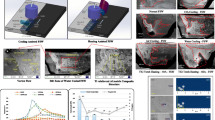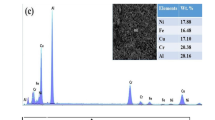Abstract
Bi-metal heat exchangers were fabricated by butt welding C1100 pure copper and SUS 304 stainless steel plates using two fiber laser oscillation methods (zigzag and circular). The microhardness, microstructure, and wear resistance of the weld zone were analyzed for both methods. The effects of adding single Ni, Ti, and Co interlayers and double Ni/Co interlayers to the welded joint were also investigated. The wear depth of the welded joint prepared using the circular oscillating mode was lower than that of the joint fabricated using the zigzag oscillating mode, which are 22 μm and 27 μm, respectively. Moreover, the zigzag oscillating mode increased the porosity of the weld area and hence lowered the wear resistance. The addition of a Ti interlayer prompted the formation of intermetallic compounds (IMCs) and thus enhanced the microhardness of the welding area. The sample with a pure Ti interlayer shows both the highest microhardness (> 400 HV) and the lowest wear depth (< 8 μm) and thus has the highest wear resistance. For both the single Co interlayer and the double Ni/Co interlayer, the average copper content in the weld zone increased. Among all of the interlayer welds, that containing a Ti interlayer has the highest microhardness (400 HV), the highest Cu content (51 wt%), and the lowest wet kinetic friction coefficient (0.15). As a result, it has the best wear resistance among all the samples with an interlayer. The resulting reduction in the kinetic friction coefficient improved the overall wear resistance of the weld zone.







Similar content being viewed by others
Data availability
All data generated or analyzed during this study are included in the present article.
References
Wang H, Gee M, Qiu Q, Zhang H, Liu X, Nie H, Song X, Nie Z (2019) Grain size effect on wear resistance of WC-Co cemented carbides under different tribological conditions. J Mater Sci Technol 35(11):2435–2446
Zhou L, Zhang J, Li S, Tian Y, Wang J, Huang M, Yuan Q, Li X, Kou Z, Zhan G, He D (2023) Effects of hardness and grain size on wear resistance of polycrystalline cubic boron nitride. Int J Refract Met Hard Mater 111:105766
Seenuvasaperumal P, Doi K, Basha DA, Singh A, Elayaperumal A, Tsuchiya K (2018) Wear behavior of HPT processed UFG AZ31B magnesium alloy. Mater Lett 227:194–198
Mahesh, Koti V, Singh KK, Singh RK (2022) Experimental and statistical investigation on the wear and hardness behaviour of multiwalled carbon nanotubes reinforced copper nanocomposites. Wear 500–501:204368
Zhao G, Yuan Y, Zhang P, Zhou T, Wang H, Li X, Zhou H (2022) Effect of hardness gradient of laser bionic coupling unit on wear resistance of 6082 aluminum alloy. Opt Laser Technol 153:108172
Chen Z, Wu C, Zhou H, Zhang G, Yan H (2022) A high-efficiency preparation method of super wear-resistant superhydrophobic surface with hierarchical structure using wire electrical discharge machining. Surf Coat Technol 444:128673
Jeong DH, Gonzalez F, Palumbo G, Aust KT, Erb U (2001) The effect of grain size on the wear properties of electrodeposited nanocrystalline nickel coatings. Scripta Mater 44:493–499
Luo Z, Zhang Z, Wang W, Liu W (2009) Effect of polytetrafluoroethylene gradient-distribution on the hydrophobic and tribological properties of polyphenylene sulfide composite coating. Surf Coat Technol 203(10–11):1516–1522
Ranjan R, Kumar Das A (2022) Protection from corrosion and wear by different weld cladding techniques: a review. Mater Today: Proceed 57:1687–1693
Ahmadi E, Goodarzi M (2022) Mechanical response and wear behavior of graphene reinforced inconel 718 composite produced via hybrid accumulative roll bonding and gas tungsten arc welding process. J Market Res 19:3059–3072
Coronado JJ, Caicedo HF, Gómez AL (2009) The effects of welding processes on abrasive wear resistance for hardfacing deposits. Tribol Int 42(5):745–749
Yan S, Meng Z, Chen B, Tan C, Song X, Wang G (2022) Experimental study on the grain evolution induced by thermal characteristics during oscillation laser welding of IN718. Mater Lett 323:132581
Ciou YC, Chang CL, Lu WH, Lin HK (2022) Mechanical and microstructural properties of dissimilar copper and stainless-steel butt welds prepared using zigzag and circular fiber laser oscillation methods. Mater Sci Eng A 859:44178
Pan S, Jin K, Wang T, Zhang Z, Zheng L, Umehara N (2022) Metal matrix nanocomposites in tribology: manufacturing, performance, and mechanisms. Friction 10(10):1596–1634
Lisiecki A (2022) Development of laser welding and surface treatment of metals. Materials (Basel) 15(5):1765
Samal P, Vundavilli PR, Meher A, Mahapatra MM (2020) Recent progress in aluminum metal matrix composites: a review on processing, mechanical and wear properties. J Manuf Process 59:131–152
Zhang Z, Li Z, Pan S, Chai X (2022) Enhanced strength and high-temperature wear resistance of Ti6Al4V alloy fabricated by laser solid forming. J Manufact Sci Eng 144(11):111011
Pan S, Saso T, Yu N, Sokoluk M, Yao G, Umehara N, Li X (2020) New study on tribological performance of AA7075-TiB2 nanocomposites. Tribol Int 152:106565
Sui YW, Li BS, Liu AH, Nan H, Guo JJ, Fu HZ (2008) Microstructures and hardness of Ti-6Al-4V alloy staging castings under centrifugal field. Trans Nonferrous Metals Soc China 18(2):291–296
da Rocha SS, Adabo GL, Henriques GEP, Nóbilo MADA (2006) Vickers Hardness of cast commercially pure titanium and Ti-6Al-4V alloy submitted to heat treatments. Braz Dent J 17(2):126–129
Roymech engineering encyclopedia Coefficients of Friction. https://www.roymech.co.uk/Useful_Tables/Tribology/co_of_frict.htm
Funding
The authors received financial support provided by the Ministry of Science and Technology of Taiwan, ROC, under Project No. MOST 110-2221-E-020-011.
Author information
Authors and Affiliations
Contributions
Chin-Lung Chang: resources, review, and visualization. Yi-Cin Ciou: investigation, formal analysis, data collection, visualization, and writing. H.K. Lin: writing, review, and funding acquisition.
Corresponding author
Ethics declarations
Ethics approval
Not applicable.
Consent to participate
Not applicable.
Consent for publication
Not applicable.
Competing interests
The authors declare no competing interests.
Additional information
Publisher's note
Springer Nature remains neutral with regard to jurisdictional claims in published maps and institutional affiliations.
Rights and permissions
Springer Nature or its licensor (e.g. a society or other partner) holds exclusive rights to this article under a publishing agreement with the author(s) or other rightsholder(s); author self-archiving of the accepted manuscript version of this article is solely governed by the terms of such publishing agreement and applicable law.
About this article
Cite this article
Chang, CL., Ciou, YC. & Lin, HK. Wear behavior of copper and stainless steel butt joints fabricated by laser oscillation welding. Int J Adv Manuf Technol 126, 4665–4673 (2023). https://doi.org/10.1007/s00170-023-11439-5
Received:
Accepted:
Published:
Issue Date:
DOI: https://doi.org/10.1007/s00170-023-11439-5




